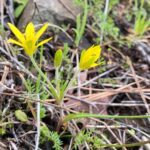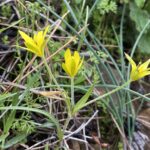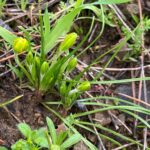Γαγέα η έμμισχη
Etymology of Gagea peduncularis: The genus is named after the English naturalist Sir Thomas Gage (1791-1820). Latin "pedunculus" means "with peduncles", because peduncularis -even though not the only one- bears peduncles arising from the stem.
There are six Gagea species in the Cypriot habitat.
Gagea peduncularis exists in most of the regions of Cyprus but it is not present in the peninsula of Karpasia. It is a plant encountered at an altitude of up to 800 metres. Its flowering period is between January and March.
How to identify Gagea peduncularis:
Peduncularis's basal leaves are 2, thread-like, grooved and glabrous, longer than the plant´s height. The cauline leaves are 1-3, alternate, lanceolate, the lower born about the middle of the stem, the other 2 smaller, all covered with soft downy hairs internally and on the margins, more or less glabrous externally, 2-8 mm wide. The cauline leaves are distinctly different from the basal leaves.
Fibrosa's leaves are fibrous; Chlorantha's leaves are very similar to the basal leaves and usually, less than 1 mm wide; Villosa is usually crowded with flowers, its basal leaf may not be the tallest, and it grows at an altitude exceeding 1100 metres; Gagea juliae's ovary is green, and the pedicels are the thinnest of the Gageas of Cyprus.




